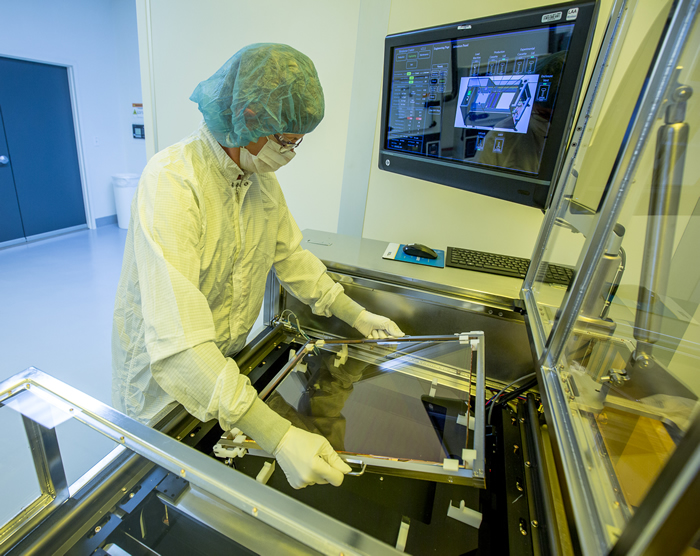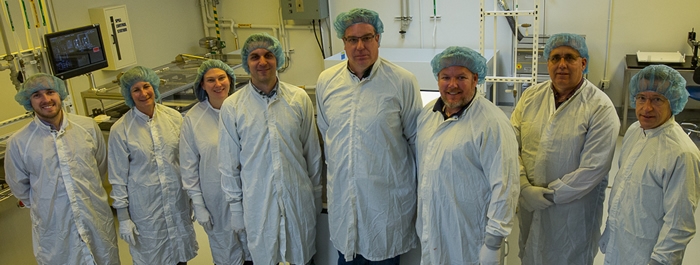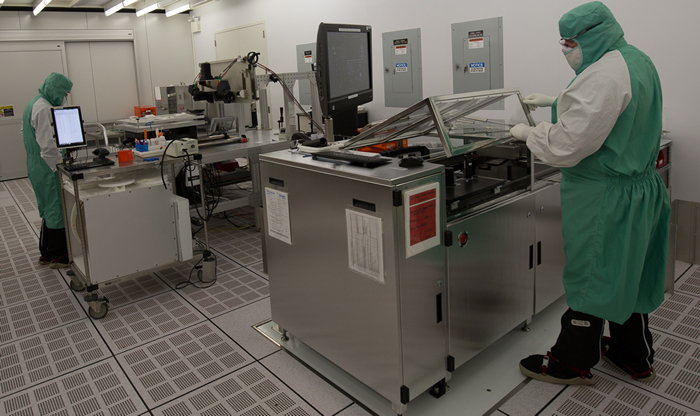Efficiency Improvements - 2016
January
Improving Optics Processing Efficiencies
NIF’s optics processing facility (OPF) provides the laser system with an average of 35 high-quality optics per week. Those optics must be as free as possible from particulate contamination, such as tiny specks of dust, which can initiate damage when the optics are exposed to NIF’s high-energy laser beams. In addition, non-volatile chemical contaminants in the air can degrade the optical performance of the sol-gel anti-reflective coatings that are applied to NIF optics in the OPF.
As a result, NIF optics require handling in ultra-clean environments similar to those used in semiconductior processing facilities. The OPF is operated as a Class 100 cleanroom, maintaining fewer than 100 particles larger than 0.5 microns in each cubic foot of air space.
The OPF teams recently completed several upgrades to the facilities to improve efficiency and quality. The wet processing side of the grating debris shield (GDS) production facility was reconfigured with a more efficient layout and new utilities to support installation of new processing equipment which had been under development in the OPF test lab for several years.
The GDS production facility is used to lithographically pattern and etch a holographic grating into the exit surface of the GDS optic. The grating diffracts 0.15 per cent of the 3ω (ultraviolet) NIF beams into the drive diagnostic (DrD) systems, and the quality and uniformity of the grating is critical to maintaining energy balance among the 192 NIF beams.
 (Above) Process engineer Ruth Hawley loads a grating debris shield (GDS) optic into the new photoresist coating system. The new system has improved motion controls, photoresist fluid handling, and automation to provide a more robust and repeatable process. GDSs are now processed in handling frames to avoid directly handling the optic. After coating, the GDSs are loaded into a new oven to cure the coating. Improved temperature controls have made the process more reliable and require less monitoring by the production staff. (Below)The GDS lab reconstruction team (from left): Robert Plummer, Ruth Hawley, Diana VanBlarcom, Marcus Monticelli, John Peterson, Mike O’Brien, John Davis, and Jim Folta. Not shown: Ed Northcutt, Steve Davis, Mark Berman, Tracy Leever, Patrick Perez, Doug Fisher, Blaire Lemire, Gary Curnow, John Schindler, Chuck Barrett, and Matt Robison.
(Above) Process engineer Ruth Hawley loads a grating debris shield (GDS) optic into the new photoresist coating system. The new system has improved motion controls, photoresist fluid handling, and automation to provide a more robust and repeatable process. GDSs are now processed in handling frames to avoid directly handling the optic. After coating, the GDSs are loaded into a new oven to cure the coating. Improved temperature controls have made the process more reliable and require less monitoring by the production staff. (Below)The GDS lab reconstruction team (from left): Robert Plummer, Ruth Hawley, Diana VanBlarcom, Marcus Monticelli, John Peterson, Mike O’Brien, John Davis, and Jim Folta. Not shown: Ed Northcutt, Steve Davis, Mark Berman, Tracy Leever, Patrick Perez, Doug Fisher, Blaire Lemire, Gary Curnow, John Schindler, Chuck Barrett, and Matt Robison.
A new imprint station for etching the holographic grating pattern into the optic has improved motion controls, etchant fluid handling, and automation to provide a more robust and repeatable process. Imprinting is a critical step because etching the grating into the optic is irreversible; process failures require refinishing the optic.
 (Above) The crystal optics processing room with clean wall treatments and re-secured racks. (Below) The main optics processing facility, a Class 100 cleanroom, received several cleanliness and safety upgrades. The OPF remodeling project team (from left): Guy Robitaille, Mike O’Brien, Dane Holdener, Robert Plummer, Jim Folta, and John Davis. Not shown: Mark Berman, John Schindler, Chuck Barrett, Matt Robison, Kevin Hunt and Toan Phan.
(Above) The crystal optics processing room with clean wall treatments and re-secured racks. (Below) The main optics processing facility, a Class 100 cleanroom, received several cleanliness and safety upgrades. The OPF remodeling project team (from left): Guy Robitaille, Mike O’Brien, Dane Holdener, Robert Plummer, Jim Folta, and John Davis. Not shown: Mark Berman, John Schindler, Chuck Barrett, Matt Robison, Kevin Hunt and Toan Phan.
Ultrapure water (UPW) is essential for processing optics that can withstand high laser fluences. The old UPW system was increasingly unreliable, and undersized filters were causing cavitation (bubble formation) at the final pump, possibly limiting the damage performance of NIF optics. The system has been upgraded with new processing skids and controls. The new system has higher-capacity deionization resin beds and filters, and is equipped with built-in backup pumps so that pump failure does not result in system downtime. Finally, the recirculation loop inside the OPF was tuned up to enhance the purity of the water.



